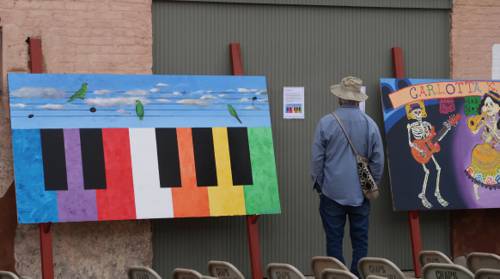
FAQ About The Role of Latin Jazz in Global Music Evolution

What is Latin Jazz and how did it originate?
Latin Jazz is a genre of music that merges rhythms and instrumentation from Latin American countries with the structure and improvisational elements of jazz. It originated in the 1940s and 1950s, largely in New York City, through the fusion of Afro-Cuban rhythms with the jazz styles of the time. Key figures in the development of Latin Jazz include musicians like Dizzy Gillespie and Chano Pozo, who combined bebop with Cuban rhythms to create a new, vibrant sound.

How has Latin Jazz influenced modern music genres?
Latin Jazz has significantly influenced a variety of modern music genres by incorporating Latin rhythms and instruments, leading to the development of genres such as Salsa, Bossa Nova, and even influencing rock and pop music. The syncopated rhythms and percussive elements of Latin Jazz have added new textures and sophistication to music worldwide, inspiring artists across diverse genres.

Who are some of the most famous Latin Jazz musicians?
Some of the most renowned Latin Jazz musicians include Tito Puente, who was known as the "King of Latin Jazz," and Arturo Sandoval, a renowned trumpet player. Others include Chico O'Farrill, Paquito D'Rivera, and the iconic pianist, Eddie Palmieri. Each of these artists contributed to the expansion and global recognition of Latin Jazz through their innovative styles and musical mastery.

What instruments are typically used in Latin Jazz?
Latin Jazz typically features a blend of traditional jazz instruments such as the piano, double bass, and saxophone, alongside Latin American instruments like congas, bongos, timbales, and claves. The rich percussion instruments often drive the rhythm section, which is a hallmark of the genre, creating vibrant and complex musical textures.

How does Latin Jazz differ from traditional jazz?
While traditional jazz primarily focuses on swing rhythms and blues elements, Latin Jazz incorporates a variety of Latin American rhythms, such as the clave, and often includes different instruments and percussive elements. This fusion creates a hybrid sound that retains the improvisation and harmonic complexity of jazz while embracing the rhythmic vibrancy of Latin music.

What are some key albums in the Latin Jazz genre?
Several key albums have shaped the Latin Jazz genre, including "Mambo Diablo" by Tito Puente, and "Cuba Linda" by Paquito D’Rivera. Another major work is "Spanish Eyes" by Dave Valentin. These albums showcase the rich diversity of Latin Jazz, featuring innovative compositions and high-energy performances that have captivated audiences worldwide.

How has Latin Jazz impacted cultural exchanges globally?
Latin Jazz has played a significant role in global cultural exchanges by acting as a bridge between Latin American and other international music traditions. It has facilitated collaborations between artists from various cultural backgrounds, promoting dialogue and understanding through music. This has not only enriched the global music scene but also increased awareness and appreciation of Latin American cultural contributions.

What are some famous Latin Jazz festivals around the world?
Notable Latin Jazz festivals globally include the Havana International Jazz Festival in Cuba, which showcases the best of Latin Jazz, and Brazil's Ibirapuera Park Jazz Festival. In the United States, the Newport Jazz Festival and the International Jazz Festival in Chicago often feature Latin Jazz artists, indicating the genre's widespread appeal and its place on major jazz stages globally.

What role did the Afro-Cuban rhythm play in the development of Latin Jazz?
The Afro-Cuban rhythm is foundational to Latin Jazz, providing the complex, syncopated rhythms that distinguish the genre from other forms of jazz. This rhythm, embodied by the clave, serves as the backbone for compositions and improvisations within Latin Jazz, enabling musicians to explore diverse and innovative musical landscapes while remaining rooted in traditional Cuban musical elements.

How has technology affected the evolution of Latin Jazz?
Technology has profoundly affected the evolution of Latin Jazz by allowing for sophisticated recording techniques, electronic instrumentation, and global distribution. Artists can now incorporate electronic elements into their music, experiment with new sounds, and reach wider audiences through digital platforms. This technological advancement has enabled greater innovation within the genre, keeping it vibrant and relevant in today's music scene.

Are there any misconceptions about Latin Jazz?
A common misconception about Latin Jazz is that it is solely a derivative of Cuban music, while in reality, it draws on a variety of Latin American influences beyond just Cuba, including Puerto Rican, Brazilian, and Afro-Caribbean traditions. Additionally, some may incorrectly assume that Latin Jazz is a narrow genre, when it actually encompasses a wide range of styles and influences that contribute to its rich diversity.

What distinguishes Bossa Nova from other Latin Jazz styles?
Bossa Nova, which originated in Brazil, is distinguished from other Latin Jazz styles by its smooth, relaxed sound that often features a syncopated guitar rhythm and subtle yet complex harmonic progressions. Unlike the more percussive Afro-Cuban styles, Bossa Nova blends seamlessly with the warmth of Brazilian melodies and rhythms, making it a unique and enduring style within the broader Latin Jazz genre.

How does Latin Jazz interact with other forms of world music?
Latin Jazz interacts with other forms of world music by embracing and incorporating various musical elements from diverse cultural traditions. This genre is notably open to fusion, often integrating rhythms and styles from Africa, the Middle East, and Asia, thereby expanding its versatility and appeal. Such interactions enrich Latin Jazz, bringing new dimensions and vibrancy to its sound.

In what ways has Latin Jazz influenced Western pop and rock music?
Latin Jazz has heavily influenced Western pop and rock music by introducing elements such as complex rhythms, exotic instrumentation, and the concept of fusion. Artists like Santana have successfully blended Latin rhythms with rock, creating globally renowned hits. This cross-genre influence highlights Latin Jazz's role in broadening the sonic palettes of Western music and creating innovative musical experiences.

Is Latin Jazz popular outside of Latin America and the United States?
Yes, Latin Jazz enjoys popularity outside of Latin America and the United States. The genre has a dedicated following in Europe and Asia, where artists and audiences alike appreciate its vibrant rhythms and global appeal. International festivals frequently feature Latin Jazz acts, showcasing the genre's ability to captivate audiences worldwide and confirming its status as a global musical phenomenon.

What are the key rhythmic elements in Latin Jazz?
The key rhythmic elements in Latin Jazz include the clave, montuno patterns, and various Afro-Cuban or Brazilian rhythms. These elements are crucial for creating the syncopated and dynamic grooves that characterize the genre. Mastery of these rhythmic components allows musicians to maintain the lively and intricate sound that is synonymous with Latin Jazz.

Has Latin Jazz influenced classical music in any way?
Latin Jazz has influenced classical music by inspiring composers to incorporate Latin rhythms and melodies into their work. This cross-pollination has led to the creation of hybrid compositions that blend classical structures with the vibrant, rhythmic intricacies of Latin Jazz, expanding the expressive capabilities of classical music and fostering new interpretative possibilities for performers.

What contributions did Tito Puente make to Latin Jazz?
Tito Puente, often referred to as "The King of Latin Jazz," made substantial contributions to the genre through his pioneering work as a composer, bandleader, and performer. He was instrumental in popularizing Latin Jazz internationally, introducing new rhythmic patterns and innovative arrangements. Puente's prolific output and dynamic performances left a lasting legacy, securing his place as a defining figure in Latin Jazz history.

How does improvisation function in Latin Jazz?
Improvisation in Latin Jazz functions much like in traditional jazz, but with the incorporation of Latin rhythms and styles. Musicians often explore extensive solos that interact with intricate percussive backgrounds, allowing for spontaneous creative expression. This improvisational aspect is essential for maintaining the vibrancy and energy of Latin Jazz performances, offering musicians a boundless platform for artistic exploration.

How has Latin Jazz fostered inclusivity in the music industry?
Latin Jazz has fostered inclusivity in the music industry by bringing together musicians from diverse cultural backgrounds and promoting collaborative projects that bridge gaps between different musical traditions. It has created opportunities for underrepresented groups to showcase their talents and has helped broaden audience diversity, contributing to a more inclusive and varied musical landscape.
